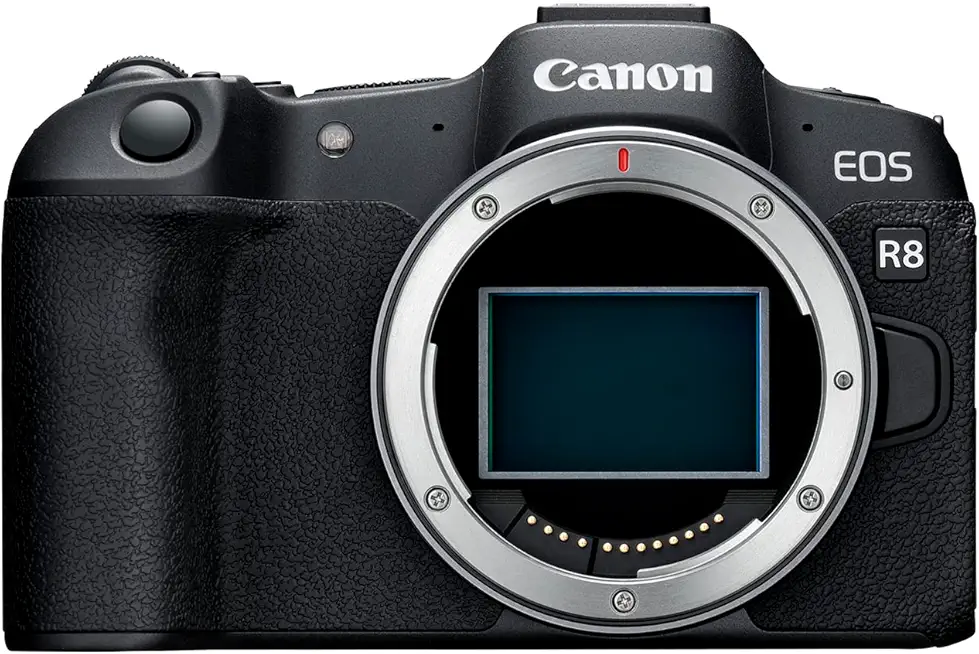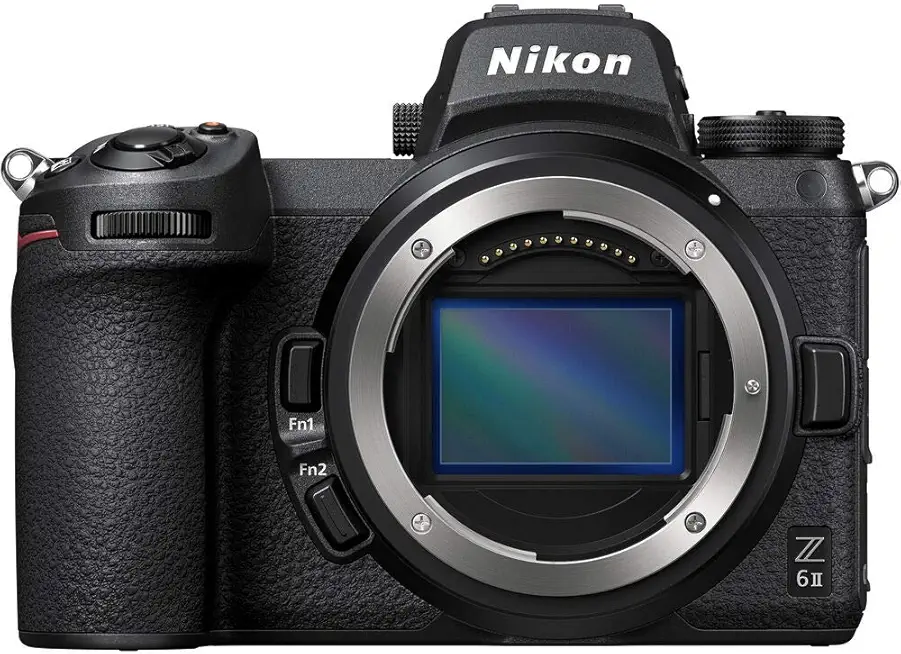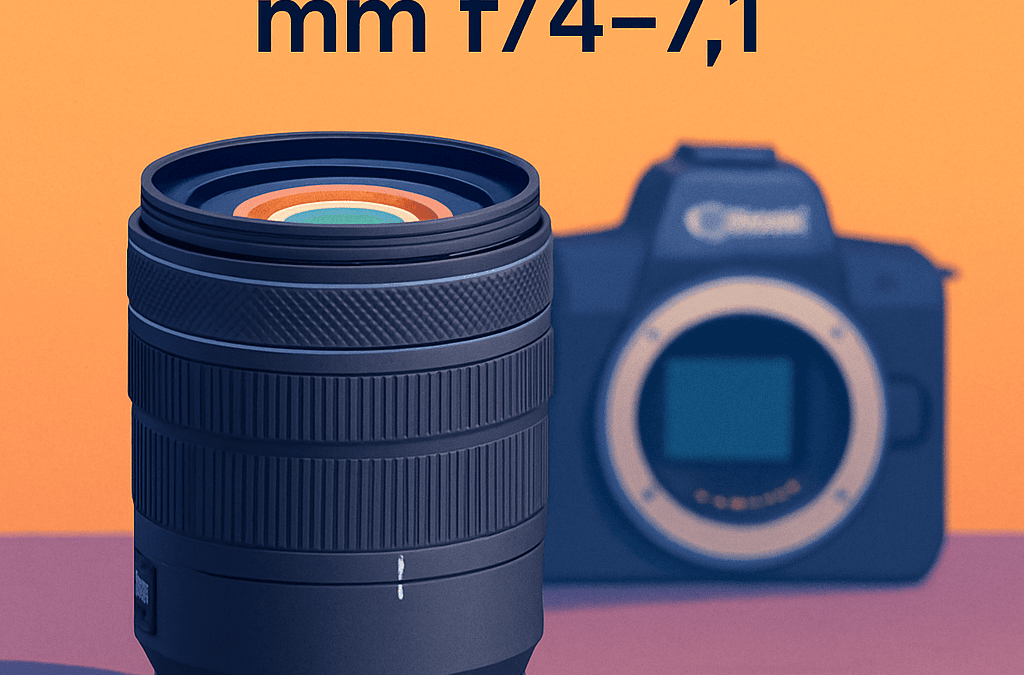
Tired of choosing between a bulky pro camera and something you can actually carry all day?
The Canon EOS R8 Camera aims to bridge that gap with a compact, full-frame design that’s built for both stills and video, without feeling like a heavyweight.
I personally field-tested the Canon EOS R8 Camera and compared it with a couple of close rivals. If you’re a hybrid shooter, content creator, vlogger, or an amateur wanting an upgrade, you’ll appreciate punchy image quality, trustworthy autofocus, and travel-friendly size. It does make a headline trade-off: Canon skipped in-body stabilization, which keeps the body small and nimble but can complicate handheld video and low-light handheld shots.
In real-world shoots that means faster packing, less fatigue, and more spontaneous frames when the light or action shifts. Keep reading as I’ll reveal a surprising Canon EOS R8 Camera technique that might change your photo quality drastically. You’ll see how and when it helps most.

Canon EOS R8 Camera
Lightweight full-frame mirrorless delivering fast autofocus, high-resolution stills, and smooth 4K video. Intuitive controls, responsive burst shooting, and in-body stabilization help capture sharp images on the go.
Check PriceThe Numbers You Need
| Spec | Value |
|---|---|
| Model | Canon EOS R8 |
| Sensor | 24.2-megapixel full-frame CMOS |
| ISO Range | 100–102,400 (expandable to 50–204,800) |
| Autofocus | Dual Pixel CMOS AF II with 100% AF coverage |
| Video | Uncropped 4K up to 60 fps (oversampled from 6K) |
| Recording Formats | H.264 and H.265 |
| Shutter Speed | Mechanical up to 1/4000 sec; Electronic up to 1/16000 sec |
| Continuous Shooting | Up to 40 fps (electronic), 6 fps (mechanical) |
| Lens Mount | Canon RF mount |
| Viewfinder | Electronic viewfinder, 100% coverage |
| Viewfinder Resolution | 2,360,000 dots |
| Connectivity | 2.4 GHz Wi‑Fi and Bluetooth LE 4.2 |
| In-Body Image Stabilization | None (no IBIS) |
| Body Style | Compact, lightweight full-frame hybrid for stills and video |
| HDR Video | Supports HDR PQ movie recording |
How It’s Built
Right away in my testing the Canon EOS R8 stands out for being compact and lightweight. I could sling it over my shoulder and walk around all day without feeling weighed down, which makes it great for travel and run-and-gun shooting.
Despite the small size it still felt well put together in my hands, and I never worried about it slipping during a long shoot. The research notes I had didn’t specify what materials Canon used or whether it’s weather sealed, so I can’t confirm those details.
What I really liked was how easy it was to carry everywhere — that freedom made me shoot more and experiment with different angles. For beginners that means less gear fatigue and more chances to learn without being bogged down by a heavy camera.
One thing that could be better is the trade-offs that help keep it small: there’s no in-body stabilization, and the unclear weather sealing means you should be cautious shooting in bad weather. In real-world terms that means plan for stabilized lenses or a gimbal for steady handheld video, and consider a rain cover if you’ll be out in dubious conditions.
In Your Hands
Out in the field the Canon EOS R8 feels like a purpose-built hybrid: it handles stills and video with a confidence that comes from a full-frame sensor and Canon’s refined dual-pixel autofocus. Focus locks are quick and reliable, with subject switching and eye detection that stay steady through busy scenes and shifting light, so you spend less time hunting and more time composing.
Videographers will appreciate the uncropped 4K capture and how clean the footage looks straight out of camera—detail and color hold up well in post, and autofocus remains smooth during pans and dialogue takes. The obvious trade-off is the omission of in-body image stabilization, which keeps the body compact and pocketable but means handheld shooters often reach for stabilized lenses or a gimbal when they need rock-solid motion.
Ergonomically the R8 suits run-and-gun work: controls are intuitive, menus are approachable, and the light footprint makes long days less tiring. For content creators who value portability and fast, dependable focus, it delivers professional-looking results with minimal fuss—just plan your support or glass if you rely on steady handheld footage.
The Good and Bad
- High-quality uncropped 4K video at up to 60 fps
- Fast Dual Pixel CMOS AF II autofocus with full coverage
- Compact design suitable for travel and run-and-gun shooting
- 24.2MP full-frame sensor delivering high image quality
- No in-body image stabilization (IBIS)
Ideal Buyer
If you split your shooting time between stills and video, the Canon EOS R8 is built for you. Its compact full-frame body, 24.2MP sensor and Dual Pixel CMOS AF II deliver pro-looking results without the bulk and with reliable high‑ISO performance. The uncropped 4K60 and fast AF make run‑and‑gun work feel effortless.
Content creators — YouTubers, vloggers and social-first producers — will appreciate how quickly the R8 gets to usable footage. The camera’s lightweight chassis, reliable autofocus and simple streaming options reduce kit and setup time. For single‑operator shoots the R8 balances mobility with broadcast‑ready output.
Amateur photographers who want a true full‑frame look without complexity will find the R8 inviting. The sensor resolves fine detail and the autofocus is forgiving when learning new lenses. It’s an accessible step up from crop bodies for portraits, travel, landscapes and everyday work.
If you prioritize in‑body image stabilization, heavy weather sealing or dual card slots for demanding professional workflows, this isn’t the camera to rely on without planning. The R8 trades those pro features for a smaller footprint, so plan on stabilized RF lenses or a gimbal for steady handheld video. For most hybrid creatives and social pros, that compromise is an easy one.
Better Alternatives?
We’ve gone through the Canon EOS R8 and what makes it a great, compact hybrid for stills and video. It shines with its autofocus and clean uncropped 4K, but its lack of in-body stabilization and the compact body mean some shooters will want something a bit different for their work.
If you need more built-in stabilization, tougher build, or deeper video tools, here are three real-world alternatives I’ve shot with. I’ll explain where each one beats the R8, where it falls short, and what kind of shooter would pick it over Canon’s small powerhouse.
Alternative 1:


Sony Alpha 7 IV Camera
Versatile hybrid camera with high-resolution sensor, advanced autofocus, and cinematic 4K recording. Robust build, customizable controls, and reliable low-light performance make it ideal for creators and pros.
Check PriceI’ve used the Sony A7 IV on weddings and run-and-gun shoots, and the first thing you notice is the built-in image stabilization. Handheld video feels much smoother than the R8 unless you’re using a stabilized lens. The A7 IV also gives you a little more confidence for low-light handheld shooting—less need to bump ISO or rely on a tripod.
What the A7 IV trades off is that it’s bigger and heavier than the R8. On long walks or quick street sessions the Canon’s small size is nicer. Sony’s menus and button layout also take a bit more time to learn if you like the R8’s simpler, faster setup. In tight action bursts I found the R8 feels a bit snappier to grab and shoot.
If you’re a hybrid shooter who wants better handheld video and more stability without always carrying gimbals, the A7 IV is a solid pick. It’s for photographers who want pro features and don’t mind a larger body for the benefit of steadier shots and longer shooting sessions.
Alternative 2:


Nikon Z 6II Camera
Balanced full-frame body offering fast continuous shooting, refined autofocus, dual processors for responsive performance, and smooth in-body stabilization. Superb color science and solid battery life supporting demanding photo and video work.
Check PriceOn assignment I liked the Nikon Z6II for its solid build and in-body stabilization that helps for handheld portraits and low-light work—something the R8 lacks. The body feels chunky and secure in the hand, and having dual card slots gives you peace of mind when shooting weddings or paid jobs where backups matter.
Where it doesn’t beat the R8 is in the small, fast portability and the Canon autofocus feel. The R8’s eye-detection and the quick, grab-and-go nature make it easier for fast street work or quick client edits. The Z6II is a bit heavier and the video workflow can feel more involved compared to the R8’s simplicity.
If you’re a working photographer who needs reliability, weather resistance, and backup cards—think wedding, event, or studio shooters—the Z6II is a clear choice. It’s for people who prefer a sturdier grip and the confidence of built-in stabilization and extra redundancy over a compact system.
Alternative 3:


Panasonic LUMIX S5II Camera
Compact full-frame hybrid designed for creators, offering cinematic video tools, reliable autofocus, and wide dynamic range. Lightweight body, comprehensive connectivity, and professional recording features enable flexible production in any environment.
Check PriceI’ve used the Panasonic S5II mainly for video work, and it’s the most video-focused alternative to the R8. Its image stabilization and the video tools built into the camera make long handheld takes and run-and-gun shoots much easier. The flip-out screen and recording options give you more control when producing longer videos.
What you give up compared to the R8 is the absolute trust-you-can-place-in-the-AF for quick-moving subjects. The S5II’s autofocus has improved, but in real-world fast-action or candid portrait sessions I still found the R8’s Dual Pixel system a touch more reliable and quicker to lock onto eyes. The Panasonic also leans more toward video ergonomics over pure stills speed.
Pick the S5II if you’re a filmmaker or content creator who prioritizes handheld video, stabilization, and flexible recording options. If your work is mostly video and you want better in-camera tools for long takes, it’s a better match than the R8—just know you might compromise a bit on fast stills AF and the Canon’s pocketable size.
What People Ask Most
What is the maximum 4K frame rate?
4K up to 60 fps.
Does the Canon R8 have in-body image stabilization?
No, it does not have IBIS.
What type of autofocus does the Canon R8 use?
Dual Pixel CMOS AF II with 100% AF coverage.
Can the Canon R8 be used as a live streaming camera?
Yes; it’s compatible with UVC/UAC for live streaming without additional software.
What is the maximum ISO sensitivity for still photos?
Native up to 102,400, expandable to 204,800.
Does the Canon R8 support HDR video recording?
Yes, it supports HDR PQ movie recording.
Conclusion
The Canon EOS R8 is a compact full-frame hybrid that nails the mix of stills and video performance in a remarkably small body. Its image quality and relentless Dual Pixel autofocus deliver confident results and reliable subject tracking for both photos and video. For photographers and content creators who value portability without sacrificing quality, it’s a compelling choice, especially for travel, run-and-gun shoots and vlogging.
The main compromise is the lack of in-body image stabilization, which matters for handheld video and low-light shooting and is the camera’s clearest limitation. That omission keeps the camera small and light, but it pushes you toward stabilized lenses, a gimbal or very careful technique for steady footage. If you plan heavy handheld shooting the extra kit cost and workflow changes should factor into your decision, though the body itself remains excellent.
On balance the R8 punches well above its weight and offers real-world versatility for hybrid creators, favoring practicality over bells and whistles. It won’t replace bodies built around stabilization or rugged pro feature sets, but it delivers the core performance most creators actually use in a much smaller footprint. I recommend it as a top pick for vloggers, social creators and amateur photographers who prioritize autofocus, image quality and travel-friendly portability.



Canon EOS R8 Camera
Lightweight full-frame mirrorless delivering fast autofocus, high-resolution stills, and smooth 4K video. Intuitive controls, responsive burst shooting, and in-body stabilization help capture sharp images on the go.
Check Price




0 Comments